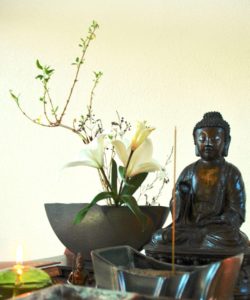Meditation at Home
 The elements of a meditation practice at home include:
The elements of a meditation practice at home include:
Solitude. Unless you are sitting with others, choose a quiet spot where you will not be disturbed. Try not to sit in a room where someone else is sleeping. If possible, let this be a space used for nothing but meditation. (Some people use a spare closet.)
Duration. Sit no less than twenty minutes each time. Thirty minutes is good; forty is better.
Keeping time. If you don’t want to watch the clock, place a kitchen timer in a drawer or closet so that the ticking is muffled but the bell can be heard. The alarm on a digital watch also works well. Some people use a lighted stick of incense of the correct length to measure the time. After some experience, your body will know when the appropriate time has elapsed and it will be necessary to look at the clock only once or twice.
Commitment. This is the most important point. Do it every day, whether it is convenient or not. Do it even if some obstacles arise. Don’t worry about “liking” it, being “bored”, “success” or “progress.”
Self-discipline. Set aside a certain time of the day for meditation, preferably in the morning soon after arising. If there is resistance to getting out of bed when the alarm rings, quickly put one foot on the floor, and the rest of you will find it easier to follow.

